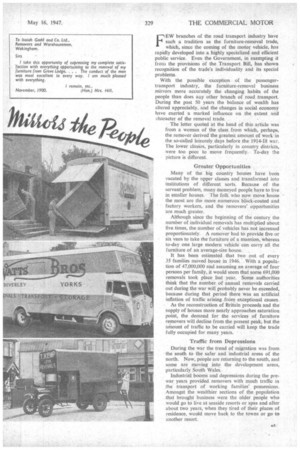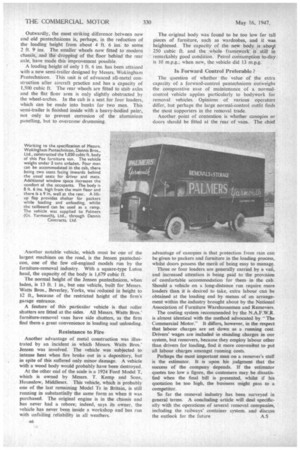F EW branches of the road transport industry have such a
Page 39

Page 40

If you've noticed an error in this article please click here to report it so we can fix it.
tradition as the furniture-removal trade, which, since the coming of the motor vehicle, has rapidly developed into a highly specialized and efficient public service. Even the Government, in exempting it from the provisions of the Transport Bill, has shown recognition of the trade's individuality and its special problems.
With the possible exception of the passengertransport industry, the furniture-removal business mirrors more accurately the changing habits of the people than does any other branch of road transport. During the past 50 years the balance of wealth has altered appreciably, and the changes in social economy have exerted a marked influence on the extent and character of the removal trade. .
The letter quoted at the head of this article was from a woman of the class from which, perhaps, the remover derived the greatest amount of work in the so-called leisurely days before the 1914-18 war. The lower classes, particularly in country districts, were too poor to move frequently. To-day the picture is different.
Greater Opportunities
Many of the big country houses have been vacated by the upper classes and transformed into institutions of different sorts. Because of the servant problem, many moneyed people have to live in smaller houses. The folk who now move house the most are the more numerous black-coated and factory workers, and the removers' opportunities are much greater.
Although since the beginning of the century the number of individual removals has multiplied about five times, the number of vehicles has not increased proportionately. A remover had to provide five or six vans to take the furniture of a mansion, whereas to-day one large modern vehicle can carry all the furniture of an average-size house. ,
It has been estimated that two out of every 35 families moved house in 1946. With a population of 47,000,000 and assuming an average of four persons per family, it would seem that some 691,000 removals took place last year. Some authorities think that the number of annual removals carried out during the war will probably never be exceeded, because during that period there was an artificial inflation of traffic arising from exceptional causes. As the reconstruction of Britain proceeds and the supply of houses more nearly approaches saturation point, the demand for the services of furniture removers will decline from the present peak, but the amount of traffic to be carried will keep the trade fully occupied for many. years.
Traffic from Depressions
During the war the trend of migration was from the south to the safer and industrial areas of the north. Now, people are returning to the south, and some are moving into the development areas, particularly South Wales.
Industrial booms and depressions during the prewar years provided removers with much traffic in the transport of working families' possessions. Amongst the wealthier sections of the population that brought business were the older people who would go to live at seaside resorts or spas and after about two years, when they tired of their places of residence, would move back to the towns or go to another resort.
Outwardly, the most striking difference between new and old pantechnicons is, perhaps, in the reduction of the loading height from about 4 ft. 6 ins. to some 2 ft. 9 ins. The smaller wheels now fitted to modern chassis, and the dropping of the floor behind the rear axle, have made this improvement possible.
A loading height of only 1 ft. 6 ins, has been attained with a new semi-trailer designed by Messrs. Wokingham Pantechnicon. This unit is of advanced all-metal construction after aircraft practice and has a capacity of 1,500 cubic ft. The rear wheels are fitted to stub axles and the flat floor area is only slightly obstructed by the wheel-arches. In the cab is a seat for four loaders, which can be made into bunks for two men. This semi-trailer is finished inside with a heavy-bodied pain*, not only to prevent corrosion of the aluminium panelling, but to overcome drumming.
Another notable vehicle, which must be one of the largest machines on the road, is the Jensen pantechnicon, one of the few oil-engined models run by the furniture-removal industry. With a square-type Luton head, the capacity of the body is 1,679 cubic ft.
The normal height of the Jensen pantechnicon, when laden, is 13 ft. 1 in., but one vehicle, built for Messrs. Watts Bros., Beverley, Yorks, was reduced in height to 12 ft., because of the restricted height of the firm's garage entrance.
A feature of this particular vehicle is that roller shutters are fitted at the sides. All Messrs. Watts Bros.' furniture-removal vans have side shutters, as the firm find them a great convenience in loading and unloading.
Resistance to Fire Another advantage of metal construction was illustrated by an incident in which Messrs. Watts Bros.' Jensen was involved. The vehicle was subjected to intense heat when fire broke out in a depository, but in spite of this suffered only minor damage. A vehicle with a wood body would probably have been destroyed.
At the other end of the scale is a 1924 Ford Model T, which is owned by Messrs. T. Kemp and Sons, Hounslow, Middlesex. This vehicle, which is probably one of the last remaining Model Ts in Britain, is still running in substantially the same form as when it was purchased. The original engine is in the chassis and has never had a rebore; indeed, says its owner, the vehicle has never been inside a workshop and has run with unfailing reliability in all weathers. The original body was found to be too low for tall pieces of furniture, such as wardrobes, and it was heightened. The capacity of the new body is abate 250 cubic ft, and the whole framework is still in remarkably good condition. Petrol consumption to-day is JO m.p.g.; when new, the vehicle did 13 m.p.g.
Is Forward Control Preferable ?
The question of whether the value of the extra capacity of a forward-control pantechnicon outweighs the comparative ease of maintenance of a normalcontrol vehicle applies particularly to bodywork for removal vehicles. Opinions of various operators differ, but perhaps the large normal-control outfit finds the most supporters in the removal trade.
Another point of contention is whether canopies or doors should be fitted at the rear of vans. The chief advantage of canopies is that protection from rain can be given to packers and furniture in the loading process, whilst doors possess the merit of being easy to manage.
Three or four loaders are generally carried by a van, and increased attention is being paid to the provision of comfortable accommodation for them in the cab. Should a vehicle on a long-distance run require more loaders than it is desired to take, extra labour can be obtained at the loading end by means of an arrangement within the industry brought about by the National Association of Furniture Warehousemen and Removers.
The costing system recommended by the N.A.F.W.R. is almost identical with the method advocated by " The Commercial Motor." It differs, however, in the respect that labour charges are set down as a running cost. Drivers' wages are included in standing charges in our system, but removers, because they employ labour other than drivers for loading, find it more convenient to put all labour charges amongst running costs.
Perhaps the most important man an a remover's staff is the estimator. It is upon his judgment that the success of the company depends. If the estimator quotes too low a figure, the customers may be dissatisfied when the final bill is presented, whilst if his quotation be too high, the business might pass to a competitor.
So far the removal industry has been surveyed in general terms. A concluding article will deal specifically with the operations of several removal companies, including the railways' container system. and discuss the outlook for the future A.S












































































